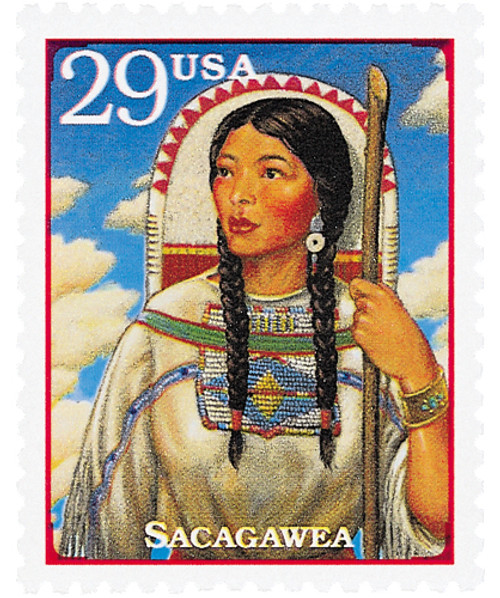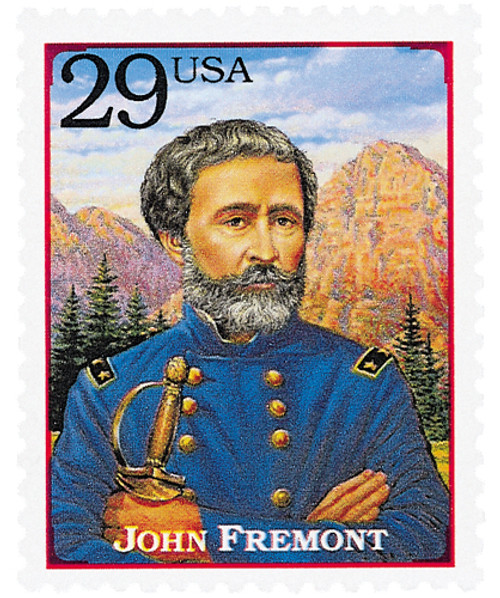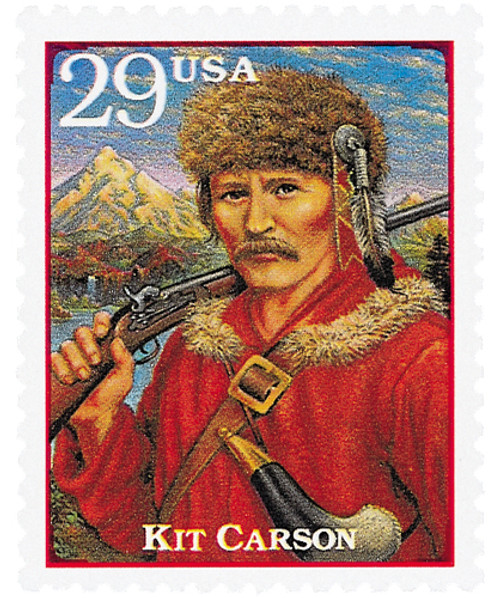
# 2869s - 1994 29c Legends of the West: Sacagawea
U.S. #2869s
1994 29¢ Sacajawea
Legends of the West
- From the corrected version of the famed Legends of the West error sheet
- First sheet in the Classic Collection Series
Stamp Category: Commemorative
Set: Legends of the West
Value: 29¢, rate for first-class mail
First Day of Issue: October 18, 1994
First Day Cities: Tucson, Arizona; Lawton, Oklahoma; Laramie, Wyoming
Quantity Issued: 19,282,800
Printed by: Stamp Venturers
Printing Method: Photogravure
Format: Panes of 20 in sheets of 120
Perforations: 10.2 x 10.1
Why the stamp was issued: The Legends of the West sheet was the first issue in the Classic Collection Series. It was developed from an idea to honor “Western Americana.”
About the stamp design: Stamp artist Mark Hess spent nearly two years working on the Legends of the West stamps. No photos of Sacagawea exist, and nearly all statues and portraits were based entirely on artists’ imaginations. Hess referenced at least 10 different artists’ depictions in the creation of his Sacagawea portrait. He based her clothes and cradleboard on the earliest Shoshone photos and artifacts he could find.
Special design details: This stamp comes from the famed Legends of the West sheet, which made headlines due to two mistakes made by the United States Postal Service and led to a string of events without precedent in the history of US stamp collecting.
One of the people to be featured on the sheet was black rodeo star Bill Pickett. After the stamps were announced, but not officially issued, a radio reporter phoned Frank Phillips Jr., great-grandson of Bill Pickett, and asked him about the stamp. Phillips went to his local post office, looked at the design and recognized it as Ben Pickett – Bill’s brother and business associate. The stamp pictured the wrong man! That was the first mistake.
Phillips complained to the Postal Service and Postmaster General Marvin Runyon issued an order to recall and destroy the error stamps. Runyon also ordered new revised stamps be created – these are the corrected Legends of the West stamps – #2869.
But before the recall, 186 error sheets were sold by postal workers – before the official “first day of issue.” This was the second mistake. These error sheets were being resold for sums ranging from $3,000 to $15,000 each!
Several weeks later the US Postal Service announced that 150,000 error sheets would be sold at face value by means of a mail order lottery. This unprecedented move was made with the permission of Frank Phillips Jr. so the Post Office could recover its printing cost and not lose money. Sales were limited to one per household. The remaining stamps were destroyed.
About the printing process: In order to include the text on the back of the Legends of the West stamps, it had to be printed under the gum, so that it would still be visible if a stamp was soaked off an envelope. Because people would need to lick the stamps, the ink had to be approved by the Food and Drug Administration as non-toxic. The printer also used an extra-fine 300-line screen, which resulted in some of the highest-quality gravure stamp printings in recent years.
First Day Cities: The Laramie, Wyoming First Day ceremony was held at the University of Wyoming. The Tucson, Arizona ceremony was held at the Old Tucson Studios, where the High Chaparral TV series and several Western movies had been filmed. The Lawton, Oklahoma ceremony was held at Fort Sill, where Geronimo was buried.
About the Legends of the West: The Legends of the West sheet was ultimately born out of a discussion to issue a stamp to honor the 100th anniversary of Ellis Island in 1992. That plan was abandoned, but was Ellis Island was featured on a postal card in the Historic Preservation Series (#UX165). Talks then pivoted to a stamp honoring “Western Americana.” Stamp artist Mark Hess was tasked with producing four semi-jumbo stamp images capturing the colorful and graphic look of old Wild West show posters. The Citizens Stamp Advisory Committee (CSAC) discussed Hess’ images and decided to expand on the idea and honor 16 significant men and women that played major roles in the expansion of the West. At one point, they considered outlaws such as Butch Cassidy, Billy the Kid, and Jesse James, but ultimately decided to “come down on the side of right and justice.” The sheet of 20 had a decorative header and descriptive text was included on the back of each stamp.
The Legends of the West stamp designs were also adapted to postal cards, #UX178-97.
History the stamp represents:
There’s limited information about Sacagawea’s early life, including her birth date, though many historians believe she was born in May 1788 near present-day Salmon, Idaho. She was a member of the Agaidika (Salmon Eater) of the Lemhi Shoshone tribe.
In 1800, when Sacagawea was about 12 years old, the Hidatsa tribe captured her and several other young girls and many people in her village were killed. She was taken to a Hidatsa village near present-day Washburn, North Dakota. The following year, Sacagawea was sold to French-Canadian fur trader Toussaint Charbonneau, who made her his wife.
Then in 1803, the United States finalized the Louisiana Purchase, acquiring the vast area that lay between the Mississippi River and the Rocky Mountains. To explore the unknown territory, President Jefferson dispatched Meriwether Lewis and William Clark. By fall the explorers had reached the Missouri River, where they hired Charbonneau as an interpreter. Because she spoke Shoshone, they agreed to add Sacagawea to their party.
Sacagawea moved into the newly built fort constructed by the expedition’s members and gave birth to a son, Jean Baptiste Charbonneau, on February 11, 1805. That April, she joined the Corps of Discovery up the Missouri River. Carrying her infant son on her back, Sacagawea guided the expedition over treacherous mountain trails and down roaring whitewater rivers.
Sacagawea often foraged for food, and when a riverboat capsized, she rescued vital supplies. The Corps then named the river after her. Her presence with the explorers also eased the suspicions of other tribes, because as Clark noted, “A woman with a party of men is a token of peace.”
When the group encountered a band of Shoshone near present-day Montana, Sacagawea discovered the tribe’s chief was her brother and was able to negotiate horses, without which the expedition might have ended. At the end of the expedition, Clark told Sacagawea’s husband that she deserved “a greater reward for her attention and services on that rout than we had in our power to give her.”
After the expedition ended, Sacagawea and her husband lived in the Hidatsa village for three years before accepting an invitation from William Clark to move to St. Louis, Missouri. There Clark helped them enroll their son in a boarding school and Sacagawea gave birth to a daughter, Lizette.
It is believed that Sacagawea, her husband, and daughter lived at the Fort Manuel Lisa Trading Post in the 1810s. A journal entry from the fort claims that Sacagawea died of “putrid fever” on December 20, 1812.
However, some Native American oral traditions tell a different story. Some believe that Sacagawea left her husband and married into a Comanche tribe and later returned to the Shoshone in Wyoming in 1860. There were tales of a woman named Porivo (chief woman) who had a Jefferson peace medal and spoke about leading white men on a long journey. Porivo died on April 9, 1884, and some people believe she was Sacagawea.
U.S. #2869s
1994 29¢ Sacajawea
Legends of the West
- From the corrected version of the famed Legends of the West error sheet
- First sheet in the Classic Collection Series
Stamp Category: Commemorative
Set: Legends of the West
Value: 29¢, rate for first-class mail
First Day of Issue: October 18, 1994
First Day Cities: Tucson, Arizona; Lawton, Oklahoma; Laramie, Wyoming
Quantity Issued: 19,282,800
Printed by: Stamp Venturers
Printing Method: Photogravure
Format: Panes of 20 in sheets of 120
Perforations: 10.2 x 10.1
Why the stamp was issued: The Legends of the West sheet was the first issue in the Classic Collection Series. It was developed from an idea to honor “Western Americana.”
About the stamp design: Stamp artist Mark Hess spent nearly two years working on the Legends of the West stamps. No photos of Sacagawea exist, and nearly all statues and portraits were based entirely on artists’ imaginations. Hess referenced at least 10 different artists’ depictions in the creation of his Sacagawea portrait. He based her clothes and cradleboard on the earliest Shoshone photos and artifacts he could find.
Special design details: This stamp comes from the famed Legends of the West sheet, which made headlines due to two mistakes made by the United States Postal Service and led to a string of events without precedent in the history of US stamp collecting.
One of the people to be featured on the sheet was black rodeo star Bill Pickett. After the stamps were announced, but not officially issued, a radio reporter phoned Frank Phillips Jr., great-grandson of Bill Pickett, and asked him about the stamp. Phillips went to his local post office, looked at the design and recognized it as Ben Pickett – Bill’s brother and business associate. The stamp pictured the wrong man! That was the first mistake.
Phillips complained to the Postal Service and Postmaster General Marvin Runyon issued an order to recall and destroy the error stamps. Runyon also ordered new revised stamps be created – these are the corrected Legends of the West stamps – #2869.
But before the recall, 186 error sheets were sold by postal workers – before the official “first day of issue.” This was the second mistake. These error sheets were being resold for sums ranging from $3,000 to $15,000 each!
Several weeks later the US Postal Service announced that 150,000 error sheets would be sold at face value by means of a mail order lottery. This unprecedented move was made with the permission of Frank Phillips Jr. so the Post Office could recover its printing cost and not lose money. Sales were limited to one per household. The remaining stamps were destroyed.
About the printing process: In order to include the text on the back of the Legends of the West stamps, it had to be printed under the gum, so that it would still be visible if a stamp was soaked off an envelope. Because people would need to lick the stamps, the ink had to be approved by the Food and Drug Administration as non-toxic. The printer also used an extra-fine 300-line screen, which resulted in some of the highest-quality gravure stamp printings in recent years.
First Day Cities: The Laramie, Wyoming First Day ceremony was held at the University of Wyoming. The Tucson, Arizona ceremony was held at the Old Tucson Studios, where the High Chaparral TV series and several Western movies had been filmed. The Lawton, Oklahoma ceremony was held at Fort Sill, where Geronimo was buried.
About the Legends of the West: The Legends of the West sheet was ultimately born out of a discussion to issue a stamp to honor the 100th anniversary of Ellis Island in 1992. That plan was abandoned, but was Ellis Island was featured on a postal card in the Historic Preservation Series (#UX165). Talks then pivoted to a stamp honoring “Western Americana.” Stamp artist Mark Hess was tasked with producing four semi-jumbo stamp images capturing the colorful and graphic look of old Wild West show posters. The Citizens Stamp Advisory Committee (CSAC) discussed Hess’ images and decided to expand on the idea and honor 16 significant men and women that played major roles in the expansion of the West. At one point, they considered outlaws such as Butch Cassidy, Billy the Kid, and Jesse James, but ultimately decided to “come down on the side of right and justice.” The sheet of 20 had a decorative header and descriptive text was included on the back of each stamp.
The Legends of the West stamp designs were also adapted to postal cards, #UX178-97.
History the stamp represents:
There’s limited information about Sacagawea’s early life, including her birth date, though many historians believe she was born in May 1788 near present-day Salmon, Idaho. She was a member of the Agaidika (Salmon Eater) of the Lemhi Shoshone tribe.
In 1800, when Sacagawea was about 12 years old, the Hidatsa tribe captured her and several other young girls and many people in her village were killed. She was taken to a Hidatsa village near present-day Washburn, North Dakota. The following year, Sacagawea was sold to French-Canadian fur trader Toussaint Charbonneau, who made her his wife.
Then in 1803, the United States finalized the Louisiana Purchase, acquiring the vast area that lay between the Mississippi River and the Rocky Mountains. To explore the unknown territory, President Jefferson dispatched Meriwether Lewis and William Clark. By fall the explorers had reached the Missouri River, where they hired Charbonneau as an interpreter. Because she spoke Shoshone, they agreed to add Sacagawea to their party.
Sacagawea moved into the newly built fort constructed by the expedition’s members and gave birth to a son, Jean Baptiste Charbonneau, on February 11, 1805. That April, she joined the Corps of Discovery up the Missouri River. Carrying her infant son on her back, Sacagawea guided the expedition over treacherous mountain trails and down roaring whitewater rivers.
Sacagawea often foraged for food, and when a riverboat capsized, she rescued vital supplies. The Corps then named the river after her. Her presence with the explorers also eased the suspicions of other tribes, because as Clark noted, “A woman with a party of men is a token of peace.”
When the group encountered a band of Shoshone near present-day Montana, Sacagawea discovered the tribe’s chief was her brother and was able to negotiate horses, without which the expedition might have ended. At the end of the expedition, Clark told Sacagawea’s husband that she deserved “a greater reward for her attention and services on that rout than we had in our power to give her.”
After the expedition ended, Sacagawea and her husband lived in the Hidatsa village for three years before accepting an invitation from William Clark to move to St. Louis, Missouri. There Clark helped them enroll their son in a boarding school and Sacagawea gave birth to a daughter, Lizette.
It is believed that Sacagawea, her husband, and daughter lived at the Fort Manuel Lisa Trading Post in the 1810s. A journal entry from the fort claims that Sacagawea died of “putrid fever” on December 20, 1812.
However, some Native American oral traditions tell a different story. Some believe that Sacagawea left her husband and married into a Comanche tribe and later returned to the Shoshone in Wyoming in 1860. There were tales of a woman named Porivo (chief woman) who had a Jefferson peace medal and spoke about leading white men on a long journey. Porivo died on April 9, 1884, and some people believe she was Sacagawea.









